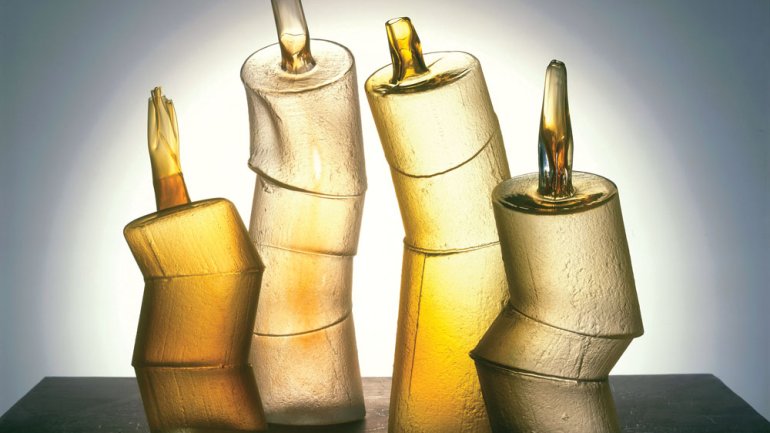A Design Path to Mastery
A Design Path to Mastery
Joel Philip Myers is a man of contrasts. As a glassblower, he’s spent his life in sweltering conditions, but he has a strong distaste for the heat. He’s been a lone wolf in the glass world, a self-taught, intensely private person; yet he speaks candidly and is known for his conviviality, having entertained countless students and artists in his home over nearly 30 years of teaching at Illinois State University. Even Myers’ work oscillates between brightly hued, playfully abstract pieces and more transparent, solemn, figurative vessels.
Perhaps contradiction comes naturally to Myers, given his artistic cultivation. He graduated from Parsons School of Design in advertising design in the early 1950s. Some 10 years later, he earned a BFA in ceramic design from the New York State College of Ceramics at Alfred University. In 1963, Myers became design director for the Blenko Glass Company in Milton, West Virginia, though his only experience with glass had come from articles about his contemporary, Harvey Littleton in Craft Horizons, this magazine’s forerunner. But Myers soon felt torn in his role at Blenko.
“I had such an emotional reaction to the activity happening on the glass factory floor,” he recalls. He knew they were making glass by hand. “I thought, ‘I can teach myself this.’ ”
He did just that, honing his skills in the evenings and on lunch breaks, observing the factory workers’ techniques and applying them to his own designs. His big break came in his first year at Blenko, when he was invited to show work at the 1964 Museum of Contemporary Crafts exhibition, “Designed for Production: The Craftsman’s Approach.” That same year, Myers attended the First World Congress of Craftsmen, where for the first time this isolated artist saw his peers at work through demonstrations led by Littleton (often called the father of the studio glass movement). “The idea was very anti-factory,” Myers says, “and here I was at Blenko, where they’ve got six people making one piece of glass!” When he returned to West Virginia, he realized there would never be a connection between his personal work and the work done in the factory.
“I began to realize I had the control to do things on my own,” he recalls. In 1968, a newly confident Myers became the first person at Alfred University to present his MFA exhibition in glass.
In 1970 Myers left Blenko to launch the glass department at ISU, today considered one of the best in the country. He knew his broad experience – as a graphic designer, potter, glass artist – would be an advantage for his students. “I found confidence in knowing that, because I was not a student of Littleton, I would have something different to offer.” And he did. Until his retirement in 1997, Myers continued to teach, even as he created work with his distinctive design sense and use of color. His molded glass vessels can be found in museums the world over, including the Corning Museum of Glass, Prague’s Museum of Decorative Arts, and Japan’s Hokkaido Museum of Modern Art. He was named to the American Craft Council College of Fellows in 1980.
Myers, who will be honored with a Glass Art Society Lifetime Achievement Award in June, has lately been enjoying what he calls otium cum dignitate, leisure with dignity – gardening, fishing, and reading at home in Marietta, Pennsylvania, with his wife Birthe, and at their summer home in Denmark. He’s also been contemplating a return to the studio.
Myers credits much of his success to being in the right place at the right time. Yet in a characteristic contrast, he acknowledges that becoming a master takes a great deal of calculation. He advises budding artists to “have as many experiences as possible and glean as much information and fresh ideas as you can: in the classroom, in the studio, and in the world at large.”
Jessica Shaykett is the American Craft Council librarian. See more images of Myers’ artwork (above) and a story about his installations from the August/September 1999 issue of American Craft (below). With almost 15,000 volumes, the ACC Library is one of the world’s largest collections of craft, art, and design publications documenting the studio craft movement. Its new Digital Collections bring thousands of these resources to the web. The library is open to the public, 10 a.m. – 5 p.m., Monday – Friday in Minneapolis.

